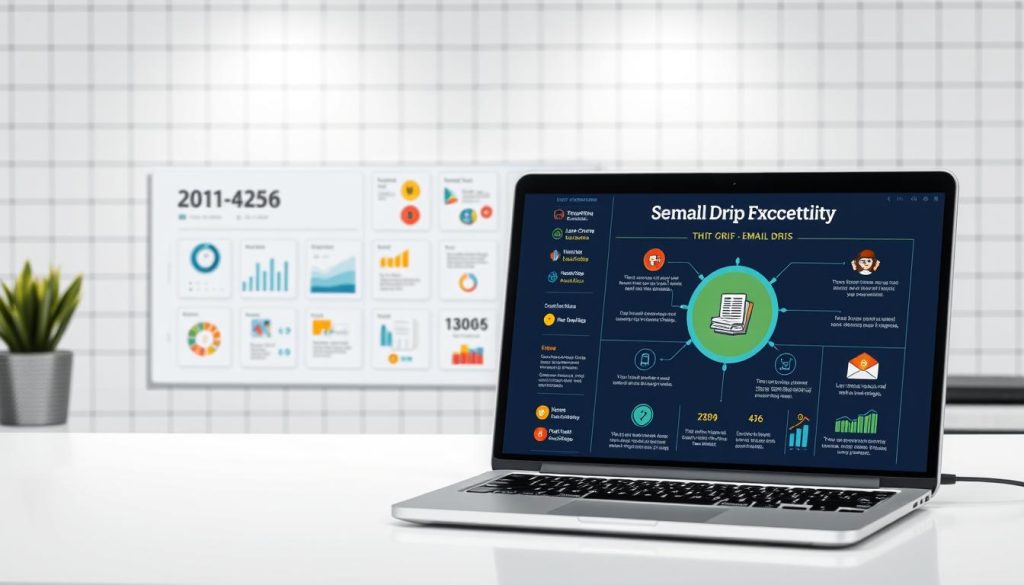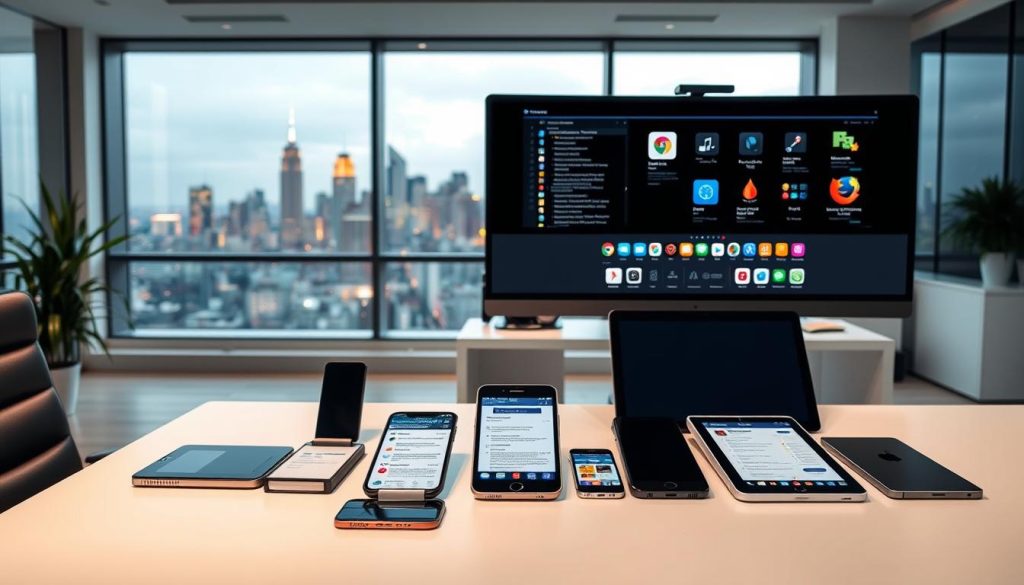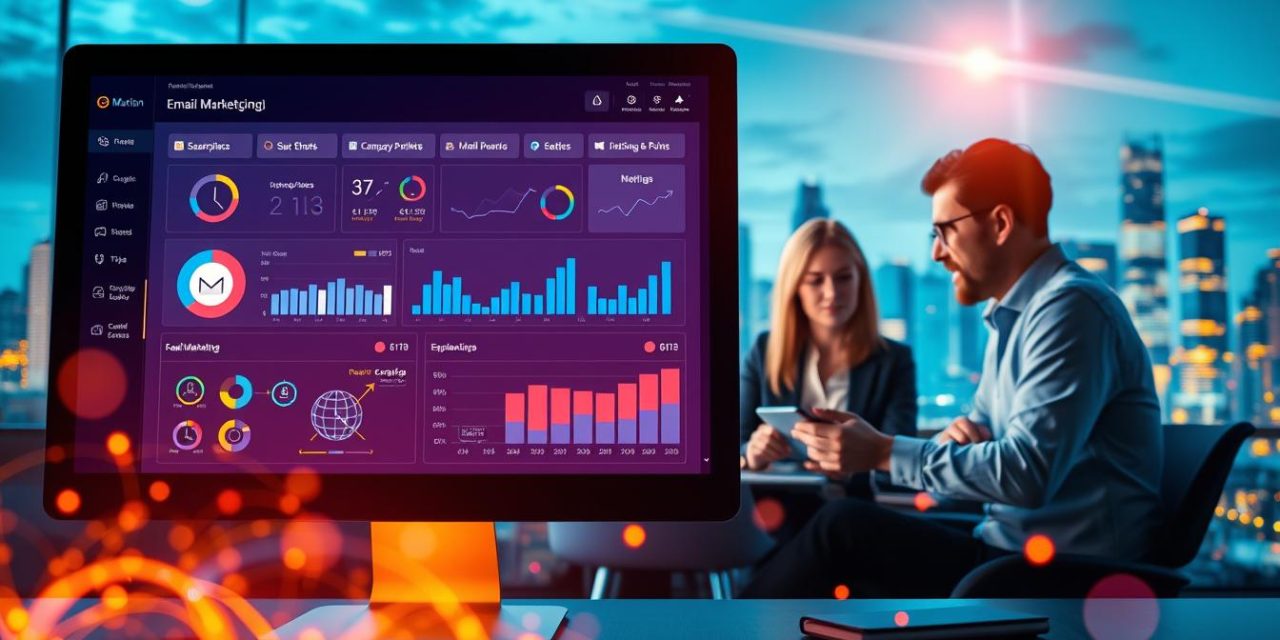Modern businesses need smart ways to talk to customers. Automated email sequences offer a powerful solution. These systems send messages based on user actions or set schedules.
This approach is called a drip campaign. It helps you stay connected without constant manual effort. You can guide people through their journey with your brand.
Unlike single email blasts, these sequences provide ongoing value. They nurture relationships and build trust over time. This method keeps your audience engaged without overwhelming them.
Our guide explores how to use this marketing strategy effectively. We cover everything from basic concepts to advanced techniques. You’ll learn to create campaigns that save time and drive results.
Table of Contents
Key Takeaways
- Drip campaigns automate customer communication through scheduled email sequences.
- They differ from traditional email blasts by providing continuous, relevant touchpoints.
- This marketing strategy nurtures leads through the sales funnel efficiently.
- Practical applications include welcome series, cart recovery, and customer onboarding.
- Proper implementation saves time while increasing conversion rates and customer loyalty.
- Strategic automation and segmentation make email marketing more effective.
- Successful campaigns deliver measurable ROI for businesses of all sizes.
Understanding Drip Campaigns
The concept behind automated email sequences stems from an agricultural technique that revolutionized farming efficiency. Drip irrigation delivers water directly to plant roots in measured amounts. This approach maximizes growth while conserving precious resources.
Drip marketing applies this same principle to customer communication. Instead of flooding subscribers with information, it delivers content gradually. Each message arrives at the perfect moment in the customer journey.
These automated systems send pre-written emails based on specific triggers or schedules. They respond to user behaviors and timing patterns. This creates a systematic approach to engagement that feels personal.
The methodology eliminates the frustration of irrelevant communications. Subscribers receive timely information when it matters most. This builds trust and maintains relevance throughout the relationship.
Unlike traditional batch emails sent to entire lists, drip campaigns respect individual timelines. They create personalized experiences automatically. Marketers set up sequences once, then the system runs continuously.
This approach serves multiple business objectives simultaneously. It nurtures leads, educates customers, and drives conversions. The versatility makes it a powerful tool in any marketing strategy.
What Is a Drip Campaign?
At its core, an automated email sequence functions as a responsive communication framework that adapts to individual user journeys. These systems send pre-written messages based on specific triggers or schedules.
An email drip campaign activates through three primary criteria. User actions like purchases or newsletter signups initiate the sequence. Time intervals such as one week after subscription also trigger messages. Status changes like account inactivity can start communication flows.
The fundamental difference from standard email marketing lies in personalization. Each recipient receives messages tailored to their specific actions and position in the customer lifecycle. This creates relevant experiences automatically.
These systems operate continuously in the background. They monitor for trigger conditions and send appropriate emails when users qualify. This ensures timely communication without manual intervention.
Sequences can range from simple two-email flows to complex multi-branch workflows. The system adapts based on how recipients interact with each message. This creates dynamic customer journeys that feel personal.
By definition, this approach must include three core components. Automation ensures emails send without manual triggering. Segmentation means different users receive different sequences. Triggers are specific conditions that initiate or advance the communication flow.
Benefits of Drip Campaigns in Email Marketing
Strategic email automation delivers measurable advantages that transform marketing results. These systems provide consistent communication that builds stronger customer relationships.
Automated sequences save significant business time by eliminating manual follow-ups. Marketers create content once, then the system delivers personalized messages to each subscriber automatically.
Research confirms that multiple touchpoints are essential before most sales occur. Mailchimp data shows 90% of consumers prefer companies that recognize them personally.
These automated systems drive higher conversion rates through strategic timing. Klaviyo’s 2024 data reveals automated flows achieve 4.67% average click rates with 1.42% order rates.
The scalability benefits make email marketing efficient for growing businesses. Whether you have 100 or 100,000 subscribers, the same sequences deliver personalized experiences.
- Builds trust through consistent, relevant communication
- Educates customers about product value systematically
- Transforms one-time buyers into loyal advocates
- Reduces unsubscribe rates with timely content
By delivering the right message at the optimal moment, automated email sequences increase sales while improving customer satisfaction. This approach creates sustainable growth for modern businesses.
Key Components of a Successful Email Drip Campaign
The foundation of any successful automated email strategy lies in understanding the essential building blocks. These elements work together to create personalized experiences that drive engagement.

Personalization and Automation
True personalization extends beyond using a subscriber’s name. It involves tailoring content to individual behaviors and preferences. This creates relevant experiences that resonate with each recipient.
Automation serves as the engine behind these personalized communications. It enables marketers to set email sequences that trigger automatically based on predefined conditions. This eliminates manual sending while maintaining perfect timing.
Trigger and Scheduling Strategies
Effective triggers respond to specific user actions like purchases or signups. They ensure messages relate directly to recent activities. Time-based scheduling sends emails after strategic intervals.
Status-based triggers monitor changes in subscriber characteristics. They activate when users reach milestones or show inactivity. Combining multiple trigger types creates dynamic sequences.
The most sophisticated approaches adapt based on both elapsed time and recipient actions. This creates personalized journeys that maximize engagement with each message.
Targeting and Segmentation for Effective Campaigns
Precision targeting transforms generic email outreach into personalized conversations that resonate with specific audience groups. This approach ensures your messages reach the right people at optimal moments.
Segmentation divides your email list into meaningful categories based on shared characteristics. This prevents overwhelming subscribers with irrelevant content.
Defining User Segments
Effective segmentation begins with analyzing subscriber data to identify distinct groups. New subscribers have different needs than long-term customers.
High-value purchasers require different messaging than occasional browsers. A marketplace connecting newsletter writers with sponsors demonstrates this principle perfectly.
| Segmentation Type | Primary Focus | Best Use Cases |
|---|---|---|
| Demographic | User characteristics | Welcome sequences, product recommendations |
| Behavioral | User actions and engagement | Cart recovery, re-engagement campaigns |
| Purchase History | Customer value and frequency | Upsell opportunities, loyalty programs |
| Engagement Level | Interaction patterns | Reactivation campaigns, premium content |
Behavior-Based Triggers
Behavioral triggers automatically respond to specific user actions. These create dynamic sequences that feel personally tailored.
The most effective marketing speaks directly to individual needs and behaviors, creating connections that generic messaging cannot achieve.
Clicking a particular link might trigger educational content. Cart abandonment can initiate recovery sequences. This approach ensures timely, relevant communication.
Continuous refinement based on performance data keeps segmentation effective over time. Proper targeting prevents common mistakes and dramatically improves engagement rates.
Crafting Engaging Welcome Email Series
The initial email communication with new subscribers sets the tone for your entire relationship. This first impression establishes brand identity and encourages ongoing engagement.

Effective welcome emails strike a balance between automation and personalization. They make subscribers feel valued as individuals rather than just another address on your list.
Best Practices for First Impressions
Send the first message immediately after signup to capitalize on peak interest. Space subsequent emails at least one day apart to avoid overwhelming new subscribers.
The 100DaysOfNoCode example shows excellent tactics. It immediately prompts action with a single-click community join link. The email provides a resource that delivers value in under 30 minutes.
Coffee brand Grind times their welcome series every 7-10 days. They recognize that customers most likely to cancel do so within the first few weeks. This makes early engagement crucial for retention.
Clearly communicate what subscribers can expect regarding frequency and content types. Building trust through transparency manages expectations from the start.
Include clear calls-to-action in your welcome emails. Whether to complete a profile or explore resources, these help new subscribers take meaningful next steps.
Leveraging Email Courses for Customer Education
Email courses represent a strategic approach to delivering valuable knowledge while nurturing potential customers. These sequential educational series build expertise through digestible content delivered over days or weeks.
This method generates leads by offering free expertise in exchange for contact information. Rob Hope’s Landing Page Hot Tips demonstrates this perfectly. He provides free course content before introducing paid e-books.
One subscriber purchased the e-book after just a few educational emails. They later recommended the course to friends. This shows how quality content builds trust that converts prospects.
Beauty brand Jones Road Beauty teaches subscribers to use new products effectively. Their emails include step-by-step instructions, product visuals, and shade-finding quizzes. Subsequent messages offer usage tips and complementary product suggestions.
| Course Type | Primary Goal | Ideal For |
|---|---|---|
| Product Education | Feature adoption | Complex products requiring explanation |
| Skill Building | Expertise development | Services demonstrating value |
| Brand Introduction | Relationship building | New companies establishing trust |
Educational email series work particularly well for complex offerings. They break information into manageable pieces rather than overwhelming recipients. This approach positions your brand as a helpful educator rather than just a seller.
The gradual trust-building often results in word-of-mouth marketing. Satisfied learners recommend courses to colleagues, expanding reach organically. This makes subsequent promotional email campaigns more effective when introducing paid offerings.
Driving Conversions with Abandoned Cart Strategies
When customers add products to their cart but don’t complete the purchase, strategic email sequences can bring them back. This scenario occurs frequently across e-commerce platforms, representing significant revenue potential.

Data from Klaviyo reveals exceptional performance for cart recovery emails. These messages achieve nearly 50% open rates with 7% click-through rates. The revenue per recipient averages $3.58, outperforming other automation types.
Tips to Recover Abandoned Carts
Effective abandoned cart recovery requires timely intervention. Send the first reminder within hours while products remain fresh in the customer’s mind. Follow up with incentive offers after one day.
Personalization dramatically improves conversion rates. Show the specific items left behind and use the customer’s name. Headspace demonstrates this approach with personalized messaging and clear call-to-action buttons.
Uncommon James offers 20% discounts in subject lines. They display abandoned products individually with separate purchase options. This allows partial cart completion rather than requiring full transactions.
| Email Timing | Primary Goal | Key Features | Best Practices |
|---|---|---|---|
| 2-4 hours after abandonment | Gentle reminder | Product images, cart link | No pressure, helpful tone |
| 24 hours later | Incentive offer | Discount code, urgency | Limited-time promotion |
| 48-72 hours later | Final opportunity | Last chance messaging | Stock warnings, strong CTA |
These automated sequences work alongside broader remarketing campaigns to maximize recovery. Remove purchase friction with direct cart links and mobile optimization. Multiple messages typically outperform single emails for complete cart recovery.
Encouraging Upgrades and Premium Engagement
Upgrade-focused email automation transforms casual users into loyal premium subscribers through strategic communication. These systematic sequences identify when users show readiness for advanced features.
Nudging Users Toward Premium Features
YouTube demonstrates effective subscription management with autoresponder emails. They alert users about premium account auto-renewal issues with clear call-to-action buttons.
Rob Hope rewarded engaged users with discount codes after they interacted with free content. This approach recognizes demonstrated interest and incentivizes conversion.
| Upgrade Strategy | Timing Trigger | Key Elements | Conversion Rate |
|---|---|---|---|
| Feature Limit Hit | When user reaches free tier limits | Premium benefit highlights | High conversion potential |
| Engagement Reward | After significant free feature usage | Discount codes, success stories | Medium to high conversion |
| Auto-renewal Reminder | Before subscription expiration | Service continuity emphasis | Excellent retention rates |
| Complementary Feature | When user encounters related needs | Problem-solution framing | Strong contextual conversion |
Best practices include clear benefit articulation and single prominent call-to-action buttons. Limited-time offers create urgency while reducing price resistance.
Effective segmentation ensures messages target users most likely to convert. This prevents annoying satisfied free-tier users who aren’t ready to upgrade.
Top Applications for Building Drip Campaigns
Various software platforms exist to help marketers create effective automated email workflows with varying levels of complexity. These tools transform manual follow-up processes into systematic communication systems.

Review of Leading Tools
Mailerlite offers user-friendly automation with flexible workflow builders starting at $15 monthly. Its A/B testing capabilities and strong deliverability make it ideal for small businesses.
HubSpot provides premium email software integrated with CRM functionality. While more expensive at $40-$3,600 monthly, it offers advanced automations suited for larger organizations.
ActiveCampaign features over 500 automated templates and basic CRM integration starting at $19 monthly. Kit specializes in serving creators with tagging and upselling features.
Brevo excels for businesses needing unlimited contacts, offering sales CRM integration from $29 monthly. Each platform serves different marketing needs effectively.
Choosing the Right Platform
Selecting the best tool requires evaluating automation flexibility and segmentation capabilities. Consider integration with existing systems and analytics depth.
Migration between platforms involves significant effort, so testing free trials before commitment is essential. The right choice depends on specific business requirements and growth plans.
Small businesses often benefit from affordable options like Mailerlite, while enterprises may require HubSpot’s advanced capabilities. Proper platform selection dramatically impacts email marketing success.
Real-World Examples of Drip Marketing Success
Examining actual business implementations reveals how automated email strategies deliver tangible results. Leading brands across industries provide valuable lessons in systematic communication.
UK coffee subscription service Grind sends emails every 7-10 days to new subscribers. These messages introduce their brand story and head roaster Howey. This approach reduces early cancellations by building immediate connection.
Cosmetics company Barry M creates urgency with birthday emails for rewards members. They offer bonus points that expire after one year. This makes customers feel valued while driving purchases.
Jones Road Beauty excels at educational content through their email series. They teach subscribers to use products like tinted face powder. Step-by-step instructions and shade quizzes provide practical value.
Luxury fashion house Marc Jacobs personalizes welcome emails brilliantly. They feature products that new subscribers clicked during site visits. This demonstrates sophisticated behavioral tracking.
These diverse examples share common success factors. Personalization based on customer data creates relevance. Strategic timing aligns with natural customer journeys. Clear value propositions balance promotion with genuine helpfulness.
Automation and Personalization Best Practices
Artificial intelligence now powers sophisticated email marketing tools that deliver unprecedented personalization capabilities. These systems analyze subscriber behavior to determine optimal send times for each individual. They automatically customize email content to boost engagement rates significantly.
Modern consumers expect brands to know their preferences and deliver relevant content. Failure to provide personalized experiences often drives customers to competitors. Advanced platforms like Klaviyo enable real-time segmentation that automatically updates subscriber lists based on behavior changes.
AI-powered systems can analyze email replies to determine whether automated responses suffice or human intervention is needed. This ensures efficient resource allocation while maintaining quality customer interactions. Real-time deliverability insights help marketers identify and resolve issues immediately.
True personalization extends beyond inserting names into subject lines. Sophisticated automation customizes product recommendations, content topics, and messaging tone based on individual subscriber data. The most successful approaches balance automation efficiency with authentic personalization.
Best practices include starting with simple workflows and gradually adding complexity. Regular review of automated sequences ensures continued relevance. Testing different personalization variables and maintaining human oversight prevents errors. Effective email marketing uses technology to scale one-to-one communication rather than replacing genuine relationship-building.
Optimizing Email Campaign Performance Through Testing
Even the most carefully planned email sequences need regular performance evaluation to stay relevant. Automated systems require ongoing monitoring to maintain effectiveness as subscriber behaviors change.
Continuous improvement through systematic A/B testing separates successful strategies from mediocre ones. This approach compares different elements to identify what resonates best with your audience.
Implementing A/B Testing
Test one variable at a time for clear results. Subject lines, send times, and call-to-action wording represent common testing areas. Each test should run long enough to gather statistically significant data.
Make sure to test with representative subscriber segments. What works for new users might not engage long-term customers. Proper segmentation ensures relevant insights.
Analyzing Campaign Metrics
Focus on metrics aligned with your specific goals. Welcome series might prioritize open rates, while sales sequences emphasize conversion rates. Each email in your series serves a different purpose.
| Metric | What It Measures | Optimization Focus |
|---|---|---|
| Open Rate | Subject line effectiveness | Testing different phrasing approaches |
| Click-Through Rate | Content relevance and CTA strength | Improving link placement and wording |
| Conversion Rate | Overall sequence effectiveness | Adjusting timing and content flow |
| Unsubscribe Rate | Message frequency or relevance | Refining targeting and content value |
Low click-through rates suggest weak calls-to-action or irrelevant content. Low conversion rates might indicate poorly timed sales pitches. Systematic troubleshooting identifies specific improvement areas.
Make sure trigger conditions align perfectly with message content. Mismatched automation creates frustrating experiences that damage subscriber relationships. Regular performance reviews ensure each email serves its intended purpose.
Conclusion
Modern customer engagement requires sophisticated communication tools that work continuously behind the scenes. Automated email sequences represent one of the most powerful assets for any marketing strategy. They systematically nurture relationships while saving valuable business time.
Once properly configured, these systems operate autonomously, delivering personalized content that converts leads into loyal customers. The comprehensive email automation benefits include higher engagement rates and significant operational efficiency. Your brand builds trust through relevant, timely communication.
Start with fundamental welcome sequences and cart recovery flows. Gradually expand to more sophisticated automation as you gather audience insights. This approach ensures your email marketing grows alongside your business, delivering consistent value to every subscriber.
FAQ
What is the primary goal of an email drip campaign?
The main objective is to nurture leads and guide subscribers through a predefined journey. This automated series of emails builds relationships over time, moving users toward a specific action like a purchase or subscription upgrade.
How does drip marketing differ from a standard email blast?
Unlike a single broadcast, a drip campaign is a sequence of messages sent automatically based on user actions or a schedule. This approach is more personalized and strategic, focusing on long-term engagement rather than immediate, one-off communication.
Can you give an example of a common trigger for a welcome email series?
A typical trigger is when a new subscriber joins your email list. This action automatically starts a welcome sequence, introducing your brand and setting expectations for future content.
What makes an abandoned cart email strategy effective?
Success hinges on timing and persuasion. Sending a reminder shortly after a user leaves items in their cart, perhaps with a special offer, can effectively recover lost sales and boost conversion rates.
Why is segmentation critical for these automated marketing campaigns?
Segmentation allows you to send highly relevant content to specific audience groups. By tailoring messages based on user behavior or demographics, you increase engagement and the likelihood of achieving your marketing goals.
Which metrics are most important for analyzing the performance of a drip campaign?
Key performance indicators include open rates, click-through rates, and conversion rates. Monitoring unsubscribe rates is also crucial to ensure your content remains valuable to your audience.





